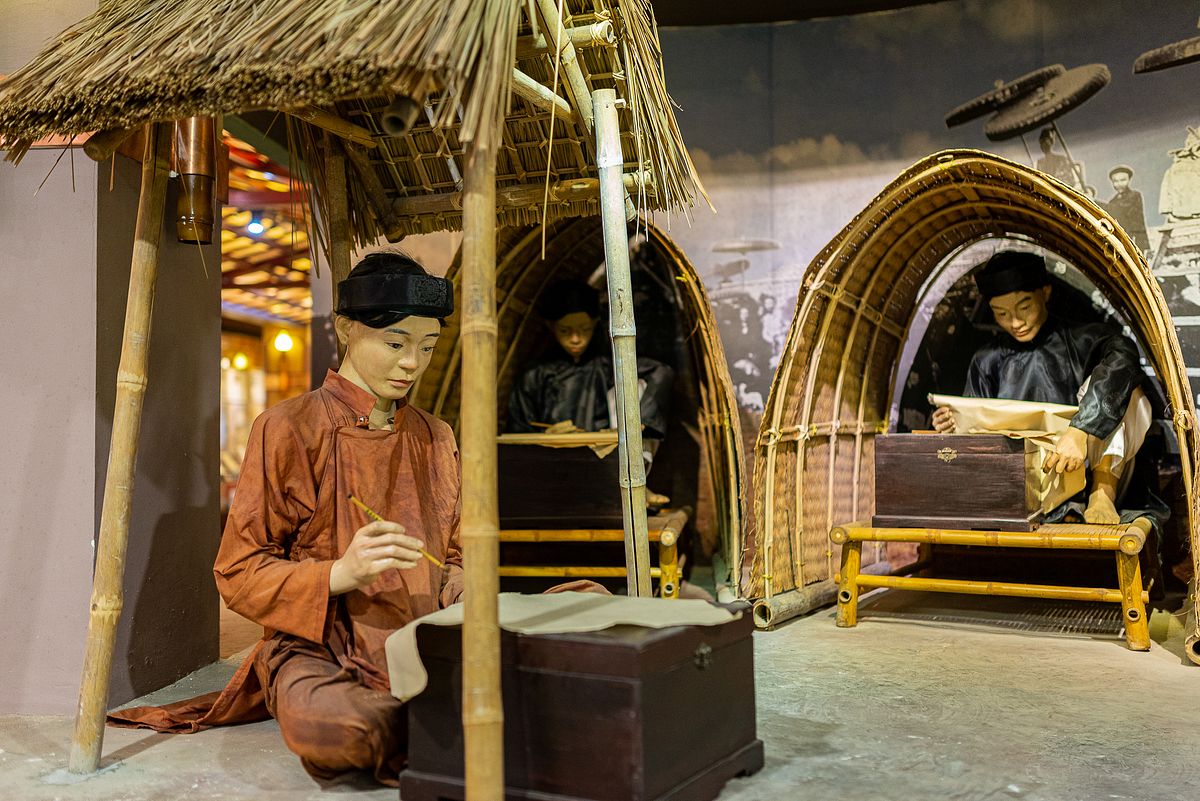From the side road of Âu Cơ Street, I turned into ngõ 275.
The building I was looking for should have stood at the end of the alley, but I couldn't spot any signage at all. Even the ngõ itself was hidden behind the shoulder of the road. It seems almost like whoever built the building didn’t care if others could find it or not.
The main gate was closed and it wasn't until I reached the parking lot that I realized that the phrase “Vietnam Museum of Literature” was displayed at all: one sign hidden behind a side gate and the other facing the back of neighboring buildings. The chance for a pedestrian to stumble upon this place was close to none. I only knew about it because a friend who had once lived nearby saw it through a window.

On the first of the museum's three floors, a big stone stands in the middle of the room. Like me, the large rock didn't seem to know what it was doing there. There wasn’t any label for it. In fact, it seemed its only job was to obscure the three lines of text on the wall that consisted of a single phrase from The Tale of Kiều written in three separate languages: “The heart is worth threefold the talent!” A staff member told me that the lines represented the evolution of the Vietnamese written language, from Chinese script, to Sino-Vietnamese, to the modern Vietnamese that we know today.

One had to stand a bit off to the side to read the verse.
The first floor contains many artifacts and displays depicting ancient and medieval Vietnamese literature. There are displays focused on famous writers like Nguyễn Trãi, Nguyễn Du and Hồ Xuân Hương — names from the previous millennia that still live on the street signs and in people’s hearts.


The display of works by Nguyễn Trãi.
The first floor also has a lively exhibition of the feudal education and examination system. Stepping into an exam, students had to build their own huts before beginning the test. The judges had their own lifeguard-style chairs from which to watch the charges below. Those who won the highest awards were honored in the palace and in their villages. I realized the Vietnamese tendency to glorify exams had been a tradition for a thousand years.


Left: An examination site with invigilators in 1897. Right: A diorama portraying exam candidates working on their scripts.
The second floor showcases writers who had won the Hồ Chí Minh award. Visitors will recognize many familiar names like Văn Cao, Xuân Diệu and Vũ Trọng Phụng. Each person is honored with a bust of their likeness as well as personal relics such as Tú Mỡ’s bicycle, Nguyễn Tuân’s cane, or Xuân Diệu's tea set.


The exhibits on the second floor.
Aside from the writers, the second floor also brings to life some characters from famous stories. One can recognize Tô Hoài's cricket, the fortune teller from Vũ Trọng Phụng’s Dumb Luck, and the bowl of shallot porridge that Thị Nở cooked for Chí Phèo.


Left: As a member of the National Assembly, Tú Mỡ could travel by car, but he still rode his bicycle to meetings every day.
Right: A collection of typewriters donated to the museum by past authors.
Going up the stairs to the third floor means traveling forward in time, from when Quốc ngữ was created, through the war era, to the modern day. The higher the floor, the fewer names I recognized. Of the dozens of writers on the third floor, I knew only Trần Đăng Khoa.




Leaving the museum, I wondered why I knew so little of today’s authors. It could be that I am not an avid reader of Vietnamese literature. But when I asked friends and family, most didn’t know the names on the third floor either. Could it be that the reading culture in Vietnam is declining and the golden age of Vietnamese literature has passed? Or simply because not enough time has passed for the names to have garnered fame?
Those questions left me feeling blue. But I reminded myself that there are still people who are working hard to produce beautiful literary works, like the stories of Nguyễn Ngọc Tư, or poems of Nhược Lạc. As long as there are writers, Vietnamese literature will continue to grow and hopefully flourish. And maybe, in my children's time, those names will be honored in this museum.
The Vietnam Museum of Literature is at 275 Âu Cơ, Quảng An Ward, Tây Hồ District, Hanoi.

















